Excursion to the Red Fort- classes 6 and 7
I travel to feel the ancient intangibles and hear the whispers of history.
A two-day excursion to the Red Fort, was organized for students of classes VI and VII on 7 and 8 February 2019. The Red Fort or Lal Quila is rightfully regarded as a jewel among India's historical legacy. It is a UNESCO World Heritage site.
The students were divided into two parties. The first group embarked on their excursion with Ms. Vandana Tiwari, Ms. Neha Sachdeva, Ms. Sarah Ghai, Ms. Pooja Bahl, Ms. Mridula Tiwari , Ms. Darshana Tope and Mr. Suraj.
[gallery link="file" order="DESC"]
The second lot of young historians visited the grand monument on Day Two, duly escorted by Ms. Archana Sharma, Ms. Kaajal Manchanda, Ms. Meenu Sethi, Ms. Bhumika and Ms. Deepali.
The fun-filled journey by bus began at around 8 am in the morning and took about 30-40 minutes.
On arrival, the children were struck by the breathtaking and intricate architecture of the magnificent red sandstone structure. The well-versed teacher- guides spoke at length about the quaint Dora work and the use of Indo-Islamic architecture.
The students basked in the warmth of tales of a world lost forever as they heard about how Mughal emperor Shah Jahan decided to build the Red Fort as the citadel of Shahjahanabad-his new capital at Delhi. The fort, which was completely constructed in the year 1648 remained the residence of the Mughal emperors until 1857. Post the reign of Aurangzeb, the Mughal dynasty grew weak and that took a toll on the fort. It became a shadow of its former glory and lost its lustre, quite literally, during the rule of Farrukhsiyar, the ninth Mughal emperor.
The children were accorded glimpses of the past as they learnt about Chatta Bazaar in all its glory during the Nowruz Festival. They also saw the Naqqar Khana or the drum house that leads to the Diwan-e Aam which houses a replica of the Peacock Throne.
The spot that fascinated the children the most was Rang Mahal with its lotus fountain. Their eyes lit up at the spectacle of the simply sheer white stone mosque, the Moti Masjid, the only structure constructed by Aurangzeb at Shahjahanabad.
The children walked in the footsteps of a bygone era as they traversed the magnificent grounds of the imperial quarters-Khas Mahal. The emperors private residence captivated the young visitors with its elaborate layout of heavily embellished buildings of white marble with gilded ceilings and floral motifs. The royal palace was divided into three parts namely the chamber of telling beads, sitting room and sleeping chamber.
Adjacent to the Khas Mahal was the Muthamman Burj, a tower from where the emperor addressed his subjects or simply waved at them in acknowledgement. The heartwarming Sawan-Bhaadon pavilion was an oasis of peace and calm.
Wrapped in the wonder of a glorious past, the children visited the museum inside the fort that houses relics of the Revolt of 1857. They also saw the remnants of the Salimgarh Fort built by Sher Shah Suris successor and predates the Red Fort. Entry to this part is prohibited.
The excursion was an extremely enriching experience for all and evoked a sense of pride amongst the students. They returned replete with information after their brief sojourn in the corridors of the past.













